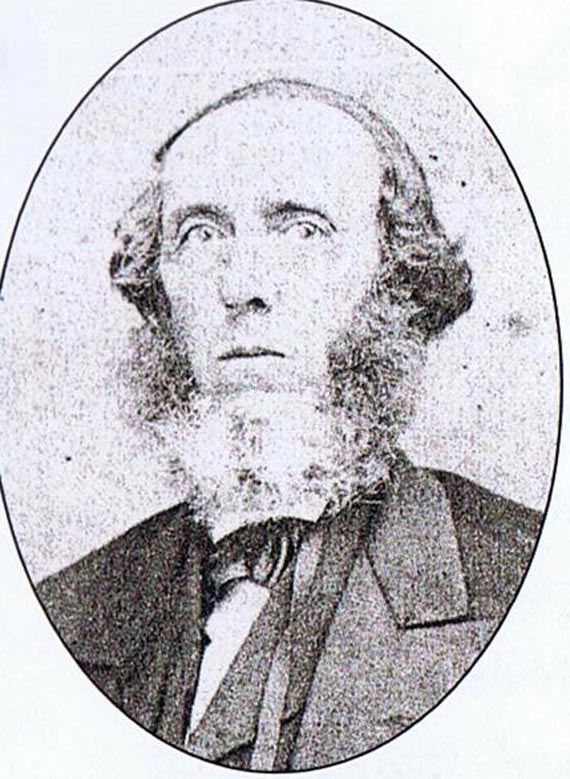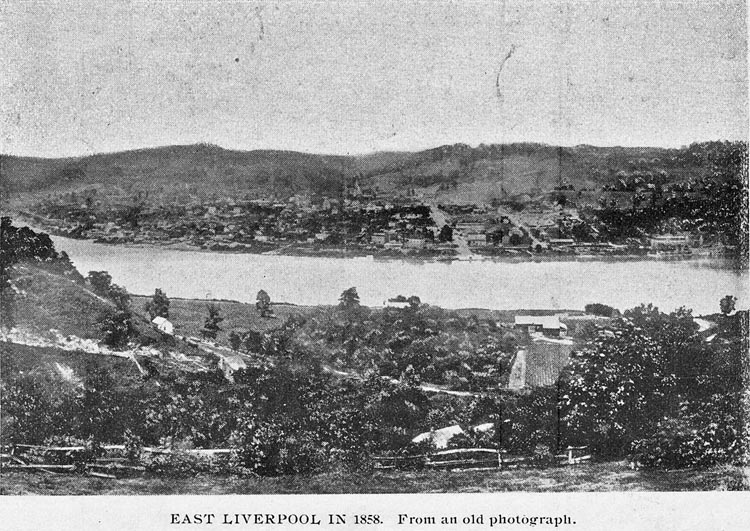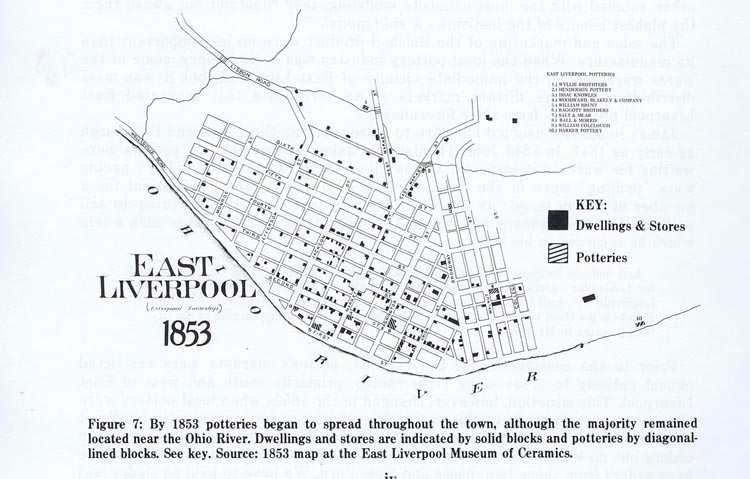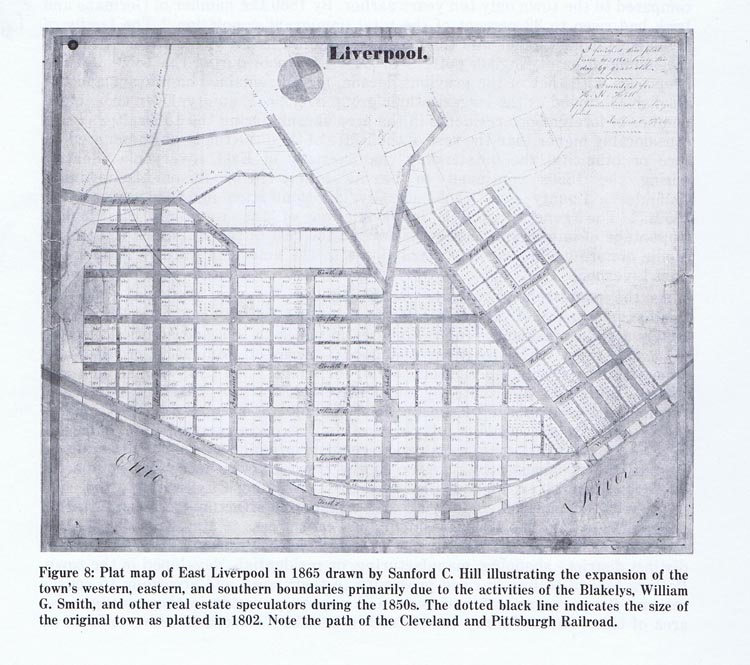From East Liverpool, Ohio.
Reflections of 200 Years.
THE SETTLERS
by GLENN H. WAIGHT
The wooded flatland flanked by hills along the northern shore of the big river was familiar to countless generations of Iroquois, Delaware and other tribes who trekked or paddled to and from hunting sites and battlegrounds.
Ohio - "beautiful stream" was the name given by the Iroquois to the vast forest area spreading west from the river. But the 1794 loss to Gen. "Mad" Anthony Wayne's white soldiers at Fallen Timbers drove the red tribes beyond the region, and cleared the way for more and more settlers.
Pennsylvanians and Virginians had been pushing at peril into the Indian lands for decades, but peace now brought a rising tide of families looking for new lives in the rich territories of the infant nation.
An Irish immigrant, living at Chartiers Valley south of "Pittsburgh," saw such a fresh start for him, his wife and eight children, and decided to purchase a home site and tract not far from where the survey for the whole Northwest Territory had begun in 1785. Two of his Chartiers neighbors - Robert Boyce and Adam Hickman - had already bought land just to the west.
Thomas Fawcett in November 1797 officially acquired nearly 1,100 acres in Sections 23 and 24 along the river from Isaac Craig, another native Irishman who had been a Colonel in the Revolution and had commanded Fort Pitt.
For more information on this: Fawcett land deed
Fawcett, then 51, paid $2 an acre for the land, and soon moved wife Isabella and the four sons and four daughters to the property which extended from the present West End to near today's Broadway. Trees and brush were cleared for a cabin and fields along Carpenter's Run, and by 1802, the aging Quaker had surveyed and filed a plat for a village he called "St. Clair" after Arthur St. Clair, then Governor of the Northwest Territory.
Within a year, the U.S. Congress had created a new state of Ohio, and the freshmen state legislators established Columbiana County from a part of the original Jefferson and Washington Counties.
A few more settlers arrived in St. Clair which most people called "Fawcett's Town," and some additional cabins were erected. A river traveler in 1807 recorded "five or six houses and a ferry."
More prominent in the district were tiny Wellsville with Steubenville to the south, New Lisbon to the north and crossroads Georgetown upriver.
The Fawcetts built a grist mill on Carpenter's Run at the foot of the New Lisbon Rd. hill, and a Welshman, Griffith Williams, started a tan yard just north of the village. Joseph Smith, Fawcett's son-in- law erected the first shingled log house along the State Road from Steubenville to Beaver.
Around 1809 a store was started by a Pittsburgh firm supplying men boring for salt on Yellow Creek.
The salt venture failed, the store closed, but later Moses Welch opened a mercantile place, and Sanford Hill, who became Mayor and a famed mathematician, came up from Wellsville to begin a store.
Fawcett's son, Tom, operated a tavern on Second St., and J. Smith began another on lower Market St. A log school was built on the Simms property up hill, succeeded afterward by a log structure on Fourth Sr. - site of the later Union, then Central School.

By 1816 John Fawcett, Daniel Moore and James Pemberton purchased 200 acres of the Fawcett land, laid out a new addition, and renamed the town Liverpool.
Soon William G. Smith - Thomas Fawcett's grandson, who had gone to Wheeling then Pittsburgh — returned in 1820, to begin business and development endeavors, (the same year Thomas Fawcett died).

William G. Smith - Thomas Fawcett's grandson
Pemberton and John Fawcett in 1825 sold their lands to Claiborne Simms of Wheeling, and concentrated on new business opportunities in the West.

Claiborne Simms
During the I820's Liverpool began to take on the appearance of an actual town.
"Claiborne Simms became the town's third proprietor and its most ardent promoter at that time" as written by William C. Gates, Jr., in the book titled "The City of Hills and Kilns."
In 1832 Simms laid out new sections north to Fourth Street and west to Jefferson Street, and sold more lots.
William C. Smith (Thomas Fawcett's grandson) purchased the shingled cabin neat Second - and Union St., opened a WILLIAM G. SMITH general store and cleared the Thomas Fawcett's Grandson rocky beach for a boat landing and ferry road.
William G. Smith built himself a brick house, and sold lots to the masons who erected similar homes.
Edward Carroll of Lisbon came to town, and constructed the Mansion House as a hotel and warehouse, and induced Dr. Benjamin Ogden of Lisbon to practice and live here.
Isabella Fawcett in 1825 joined her husband in the hillside cemetery at the far end of Fifth St., where the dead were buried in the town's first 75 years.
During the 1830's, more homes went up and the population climbed from 136 to above 500.
Expanding economic activity, growth and development of the town increased. Several wharfs were constructed, Abel Coffin established a boat yard and started constructing steamboats, including "The Liverpool" which later sank
Thomas Pratt opened a steamboat engine shop to build and repair steam engines.
The postal service was restored and "East" was added to the town's name to avoid mail mix-ups with a "Liverpool" in Medina County.
Itinerant preachers had served the community as early as 1799 when the Rev. Robert Dobbins of Yellow Creek spoke at the school house.
Presbyterians built the county's first church at Longs Run in 1800, but Liverpool lacked a worship site until 1834 when the Episcopalians erected a building on a W. 4th St. site provided by town developers John Fawcett, Moore and Pemberton.
This growth and positive prospects also brought legislative approval of the rank of incorporated village in 1834, and elections gave Phillip Cooper the post of first Mayor.
But Fast Liverpool, which had lost to Wellsville a turnpike link with Cleveland and county seat designation to New Lisbon, also failed to obtain a railroad connection to Lake Erie because of the "Panic of 1837".
Then railroads brought collapse of the Sandy Beaver Canal, which had provided profit for some local businesses in grain storage and transshipments.
However, headed upriver in 1839 was an English potter named James Bennett, who heard, possibly from Tom Pratt, a local merchant traveling on a steamboat, about East Liverpool's clay and coal - key raw materials for making plates, jugs, cups and containers which were in great demand in the many farm homes and developing towns between the Alleghenies and the Mississippi.
James Bennett was about to launch a pioneer manufacturing endeavor that would turn Ohio's sleepy gateway village into "Crockery City" - a national pottery production center.


Possibly the earliest picture of East Liverpool. Ohio. Taken from the Virginia side of the Ohio River.


A MORE DETAILED HISTORY OF THE EARLY YEARS OF EAST LIVERPOOL, OHIO
Early Clay Industries of The Upper Ohio Valley
This site is the property of the East Liverpool Historical Society.
Regular linking, i.e. providing the URL of the East Liverpool Historical Society web site for viewers to click on and be taken to the East Liverpool Historical Society entry portal or to any specific article on the website is legally permitted.
Hyperlinking, or as it is also called framing, without permission is not permitted.
Legally speaking framing is still in a murky area of the law though there have been court cases in which framing has been seen as violation of copyright law. Many cases that were taken to court ended up settling out-of-court with the one doing the framing agreeing to cease framing and to just use a regular link to the other site.
The East Liverpool Historical Society pays fees to keep their site online. A person framing the Society site is effectively presenting the entire East Liverpool Historical Society web site as his own site and doing it at no cost to himself, i.e. stealing the site.
The East Liverpool Historical Society reserves the right to charge such an individual a fee for the use of the Society’s material.